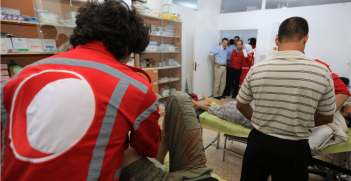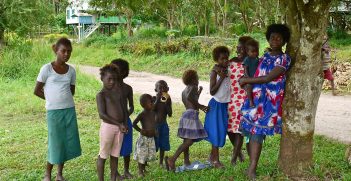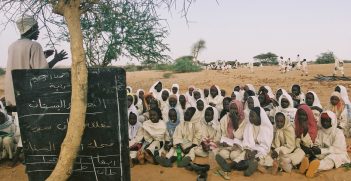Forgotten Conflicts 2021: On Resilience, After Seven Years of Conflict in Ukraine

For years now, life in the Donbas has remained split along a “contact line” of conflict since fighting broke out in 2014. The International Committee of the Red Cross (ICRC) is working with those hit hardest by the fighting.
The warm waters of the Sea of Azov roll onto the shores of the village of Berdyanskoye, situated in Ukraine’s southeast Zaporozhiye region. In the early days of summer, inhabitants of the region’s industrial strongholds used to transform it into their own summer bay. A short Eastern summer was once enough for the residents of Berdyansk, allowing them to build estates and to live comfortably for the remainder of the year, while still saving enough to pay for their children’s studies.
Multi-story summer cottages testify today to the former wealth of this village, one that is now trying to return to the old days. Today Berdyanskoe is known as a “hallway” to Shirokino, the final “contact line” before the first military positions of the conflict’s contact line that stretches for 420 kilometres to the north. However, its enterprising people remain determined to try to reopen their summer houses and attract guests. Yet, their reality remains one of life lived close to the conflict, where snipers and grenades are common.
This contact line has been stable since 2015, but with the exception of a ceasefire last year, crossfire and shelling continue. It’s as if the area is frozen in time, forcing people who live along this line of conflict to try and survive as best they can.
Hundreds of kilometres away from Berdyanskoe, life goes on for the people of Mariupol on the government-controlled side of Ukraine, and for the people of Donetsk on the non-government-controlled side. In these areas, people live ordinary lives. They go to work, study at universities, relax in restaurants and cafes. That is, they did before the global pandemic struck. Unsurprisingly, COVID-19 has made life harder for these conflict-affected communities.
What is “normal life” like in the conflict contact line area?
Aleksandr, a resident from Mariupol, describes how living amid conflict means walking past warning signs indicating the danger of sea mines. Eastern Ukraine today has one of the highest rates of unexploded ordnance and mine contamination in the world. Accustomed to the risk, Aleksandr tells stories about how before the mines, snipers, and grenades, an autumn storm once overturned a fishing boat, and fishermen, finding themselves in the water, died within minutes from the icy grip of the Azov Sea.
Every winter of the Donbas conflict signals new additions to Mariupol obituaries. Its river setting, located behind a forest, means roads are mined. However, people still go there to cut timber – cold winters force them to take risks, where they continue living while hoping not to step on a mine in the process.
It is mostly elderly people who live along the conflict contact line today. Winter is difficult for them. Those who receive pensions and can buy fuel, or those who receive humanitarian support in the form of coal for heating, save it to be able to warm their houses longer as the winter months arrive.
The function of chimneys in villages on opposite sides of the contact line occasionally extends beyond a heating device, where chimneys can perform signal functions. Families, separated and forced by conflict to live on either side of the contact line, inform each other using chimney smoke that they are alive and well. Chimneys become especially necessary during long days battling electricity cuts, when it becomes impossible to charge mobile phones and call each other, or when mobile phone lines are not working at all.
As well, in conflict zones, shops cannot function. Finding medicine is also difficult. Even if rural outpatient clinics do function, doctors only have basic tools, and are often faced with electricity and water cuts due to nearby conflict. There is no public transport between the villages along the contact line – no one wants to risk running into an unexploded shell or being hit by crossfire.
Today, distances that before the conflict could have been walked on foot in half an hour or less take hours, even days, to cross. Movement is limited by “crossing points.” People are screened on both sides of these, making travel an excessively lengthy process.
With COVID-19, the situation has worsened. Crossing points across the contact line are unstable, occasionally closed, or completely shut-down during severe outbreaks. This impacts what little public transport there is, meaning doctors often cannot reach distant villages along the contact line that desperately need their help.
Helping those whose needs are greatest
The ICRC helps people living along the conflict contact line. Despite the pandemic, the ICRC’s support has remained relatively unchanged. Food and hygiene kits are still supplied, and food for animals and vegetable seeds are distributed each spring.
And in areas where peace is gradually being restored, the ICRC is trying to help people get back on their feet. The goal is simple: to return people’s lives to pre-conflict normality. Help is provided in a variety of ways. For those willing to start their own business, the ICRC provides grants and helps write business plans. Others need ICRC help with the restoration of housing damaged by the conflict or are using greenhouses donated to them.
For several years now, the ICRC has been running its winterisation assistance program. This involves a system where in summer, coal and wood briquettes are collected to be fully distributed in the fall, free of charge, to people living in villages along the contact line.
In 2021, COVID-19 still adds to the complexity of life in conflict areas. Children are among the most affected by the fighting. With crossing points mostly closed, schools have turned to remote learning. In assisting with safe access to schools, the ICRC has now started equipping schools with wireless internet and computers to enable online lessons. While in the early years of the conflict, the priority was to equip bomb shelters and install protection on the windows of classrooms, today assistance in providing access to online educational services has become increasingly important.
Perseverance
It is the perseverance of the Ukrainian people that enables the support provided by international organisations like the ICRC to bring real results. Positive change is starting to be seen. People are applying for small business grants, learning new skills, and cultivating land. Mutual support dialogue with communities also helps organisations, such as the ICRC, to engage in meaningful, supportive ways. It allows the ICRC to remain committed to people and communities through the most difficult of life’s ordeals amid conflict.
Sanela Bajrambasic is the Communications Coordinator with the ICRC in Ukraine.
Oleksandr Vlasenko is a Spokesperson with the ICRC in Ukraine.
This article is published under a Creative Commons Licence and may be republished with attribution.





